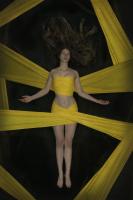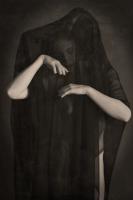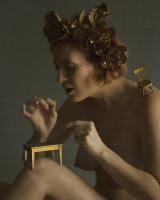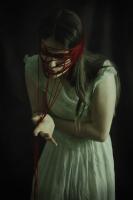Introduce yourself and describe your work and the media/genre you work in.
I’m Kathryne Grimm and I’m an award-winning and nationally exhibited fine art conceptual figurative photographer and queer trans disability activist. My photography is dramatic, sorrowful, and sometimes macabre, and I utilize their highly aesthetic nature to explore and initiate a dialogue about the issues myself and others within the disability community face. All of my works are linked together with a common narrative of pain and abandonment, represented through the solitary figure in each piece. Each element in my pieces is deliberate and highly conceptualized. Every aspect carries symbolism, from the color of the background, to the amount of skin exposed, to the way the fingers are posed. My pieces are a macabre yet aesthetically beautiful marriage pulling from my inspirations from fairy tales, mythology, and my experiences as a non-binary trans disabled person. My works echo of the past, while being timeless in nature, to mirror the existence of the disabled. We have always been present, but us and our stories have been ignored, pushed aside, abandoned, and forgotten.
What is your most important artist tool? Is there something you can’t live without in your studio?
My most important tool has to be my camera. I use a Sony a6000 with a 50mm lens. As I’m low-vision with peripheral vision blindness, I can’t actually see through a camera’s viewfinder. I rely on the LCD screen on the back of the camera that I can pull out and orient to suit my vision needs.
Who do you consider your main artistic influences?
I’m greatly influenced by German Expressionist film, specifically the works of Fritz Lang, such as The Cabinet of Dr. Caligari and Metropolis. I think my largest influence is The Pre-Raphaelites; their color palettes, the symbolism they used, and their frequent use of mythology in their works, and the aesthetics of the works in general.
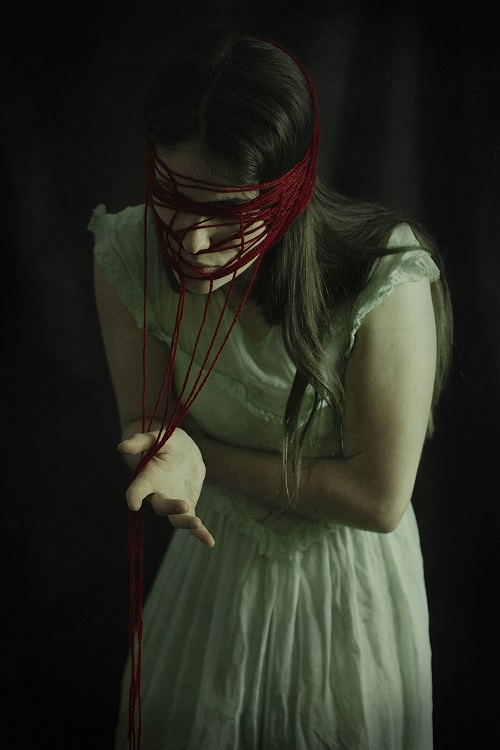
What’s the most challenging thing about your creative process? How do your photographs start and become your end vision?
The most challenging part of my process is actually finding a model that will help bring my vision to fruition. The model needs to have a pretty intense connection with the camera, and know when to be subtle or dramatic with their emoting to convey the message of the piece or pieces. But my process begins long before finding a model. I'm usually first inspired to create a piece or series based on my own personal experiences as a multiply disabled queer non-binary trans person. An individual experience or circumstance will spur me into wanting to create work about it. From there, based on my background in art history, I initially decide on a color palette that I feel will express my idea best. From that palette, I build symbolism, and the symbolism usually inspires the look of the photo or series.
Each piece I create has an almost thesis-level explanation behind it. Nothing in my pieces are by accident. Everything means something, from the color palette, to the props, how much skin is exposed, the way the hands are posed, the facial expression, everything. Once I have my full concept written out, it looks very similar to an outline for a story, and eventually becomes the basis for an image description for blind and low-vision people. From there, I create the necessary props and set, and finally I book a model for a shoot day. Once the shoot is wrapped, that is when I get to geek out in Photoshop! This is where everything comes together for me. I add layers and layers of color toning and textures, and composites if they have been planned for the piece. It is sometimes tedious, but I’m one of those weirdos that enjoys tedium!
What areas of photography/ your work are you hoping to grow and develop?
I’m very interested in exploring antique photography techniques. I’d love to make tintypes, cyanotypes, and even my own cabinet cards. I dabbled in film photography and developing my own film in high school, and that exploration of technique always stuck with me. I have a deep love of history and for me learning techniques of the past is like bringing a bit of the past to life.
Kathryne's recommendations from the Johnson County Library catalog.
Books:
The Bell Jar by Sylvia Plath - This has been my favorite book since high school. When read from the perspective of someone struggling with their mental health, it is at times humorous, poignant, and hopeful.
The Vampire Chronicles Collection by Anne Rice - This was definitely a part of my goth awakening in high school. They are decidedly fun reads, and if I’m completely honest with myself, a huge contributing factor to why my most frequented Halloween costume is a vampire.
The Picture of Dorian Gray by Oscar Wilde - A classic that is a classic for a reason, and is a book I regularly revisit. I was 10 when I first read this, and it definitely played a part in me being a spooky boi now.
Music:
The Civil Wars, self-titled album - This album is haunting, beautiful, sexy, and sounds like if a Civil War era romance became music.
Bessie Smith, The Collection . Bessie Smith is my all time favorite blues artist. The growl in her voice, the way she honestly emotes each lyric (even the bawdy ones), and the way each song she sings sounds like she’s singing your heart back to you, are my personal reasons why Bessie Smith should be your favorite, too.
Film:
Only Lovers Left Alive - This film is consistently in the running for my favorite movie of all time. It is quiet, devastatingly romantic, it feels like a sumptuous painting, and is my favorite take on a modern vampire tale.
The General - Buster Keaton is my all-time favorite silent movie star, and this was his labor of love. It is a masterpiece, hilarious, exciting, and Buster Keaton is absolutely gorgeous, so that doesn’t hurt!
Cabaret - My favorite musical of all time. You have the background of Weimar era Berlin, amazing music by Kander and Ebb, genius choreography by Bob Fosse, and a poignant story showing the progression of a liberated hedonistic Berlin to fascism.
*
https://kathrynegrimm.weebly.com/



